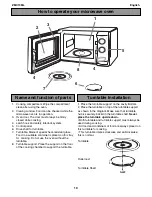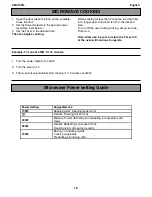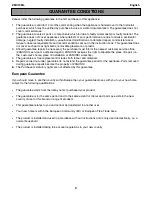
ZMC19ML
English
6
•
Paper napkins, wax paper, paper towels, plates,
cups, cartons, freezer wrap and cardboard are
great convenience utensils. Always be sure
containers are filled with food to absorb energy
and thus avoid the possibility of overheating or
ignition.
•
Many plastic dishes, cups, freezer containers and
plastic wraps may be used in the microwave
oven. Follow manufacturer’s instructions when
using plastics in the oven. Avoid using plastic
utensils with foods that have high fat or sugar
content since these foods reach high
temperatures and could melt some plastics.
•
Do not leave oven unattended, and look at it from
time to time when heating or cooking food in
plastic, paper or other combustible containers.
•
Metal utensils and utensils with metallic trim
should not be used in the microwave oven, unless
specifically recommended for microwave use.
•
Containers with restricted openings, such as
bottles, should not be used for microwave
cooking.
•
Use caution when removing a lid or cover from a
dish to avoid steam burns.
Foil containers
Shallow foil containers may safely be used to reheat
foods in your microwave oven providing the following
rules are observed:
1. Foil containers should not be more than 3 cms
(1 1/4”) deep.
2. Foil lids must not be used.
3. The foil containers must be at least two-thirds full
of food. Empty containers must never be used.
4. Foil containers should be used singly in the
microwave oven and should not be allowed to
touch the sides. If your oven has a metal turntable
or cooking rack, the foil container should be
placed on an upturned oven-proof plate.
5. Foil containers should never be re-used in the
microwave oven.
6. If the microwave oven has been in use for 15
minutes or more, allow it to cool before using it
again.
7. The container and turntable may become hot
during use, take great care when removing either
from the oven. It is advisable to use an oven cloth
or glove when doing so.
8. Remember when using an aluminium foil
container that the reheating or cooking times may
be longer than you are used to, always ensure
that the food is piping hot before serving.
Food safety
•
Do not heat food in a can in the microwave oven.
Always remove the food to a suitable container.
•
Deep fat frying should not be done in the
microwave oven, because the fat temperature
cannot be controlled, hazardous situations can
result.
•
Popcorn may be prepared in the microwave oven,
but only in special packages or utensils designed
specifically for this purpose. This cooking
operation should never be unattended.
•
Pierce foods with non-porous skins or
membranes to prevent steam build-up and
bursting. Apples, potatoes, chicken livers, and
egg yolks are examples of items that should be
pierced.
•
The contents of feeding bottles and baby food jars
are to be stirred or shaken and the temperature is
to be checked before consumption, in order to
avoid burns.
ã
WARNING
: Liquids or other foods
must not be heated in sealed containers
since they are liable to explode.
ã
WARNING
: Microwave heating of
beverages can result in delayed eruptive
boiling, therefore care must be taken when
handling the container.
ã
WARNING
: When heating liquids,
e.g. soups, sauces and beverages in your
microwave oven, overheating the liquid
beyond boiling point can occur without
evidence of bubbling. This could result in a
sudden boil over of the hot liquid. To
prevent this possibility the following steps
should be taken:
Содержание ZMC19M
Страница 1: ...8221914 30 01 USER MANUAL tAPjXWQBe MICROWAVE OVEN ZMC19ML ...
Страница 17: ......



































